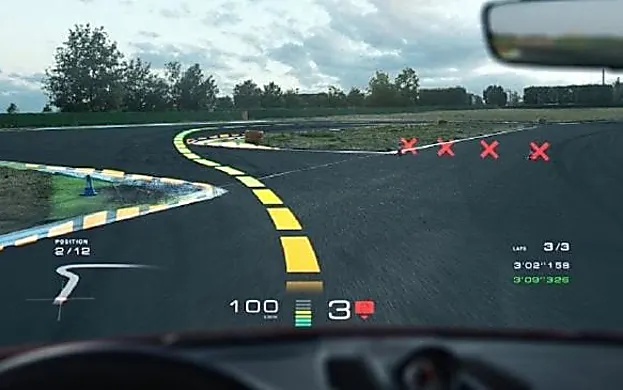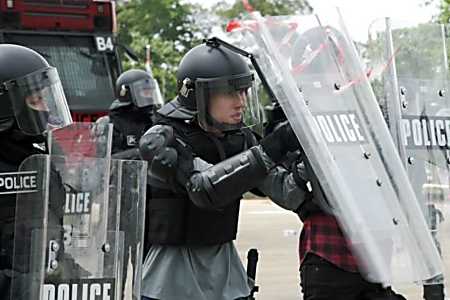Wow....pap actually going all out to sell the F35 to the pubics.....
Skip Navigation
Main navigation and Meta Navigation
To Home
Meta Main Navigation
- OpenAll SectionsAll SectionsClose
Singapore Edition International Edition
F-35: How the fifth-generation fighter jet might take RSAF to the next level
Singapore
F-35: How the fifth-generation fighter jet might take RSAF to the next level
In the first of a three-part series on the F-35 Lightning II Joint Strike Fighter, Channel NewsAsia’s Aqil Haziq Mahmud visited Lockheed Martin’s production facility for an in-depth look at the fighter jet and how it could be a battlefield game changer.
image: data:image/gif;base64,R0lGODlhAQABAAAAACH5BAEKAAEALAAAAAABAAEAAAICTAEAOw==
An F-35A taking off on a validation flight. (Photo: Lockheed Martin)
By Aqil Haziq Mahmud
20 Oct 2018 06:23AM(Updated: 25 Oct 2018 08:11PM)
Share this content
Bookmark
FORT WORTH, Texas: At the end of a highly sensitive assembly line, in the nave of an enormous aviation paint shop, lay a hulking lump of metal grey aluminium and titanium.
It was a war machine that showed some qualities of an expensive sports car, with sleek lines, perfect symmetry and a matte finish. But looks didn't mask the fact that this fighter jet is designed to be ultra deadly.
The F-35 Lightning II Joint Strike Fighter is so advanced, it can “talk” to other aircraft, see the enemy earlier and avoid being seen better than ever before. It can hunt discreetly in packs or be the all-seeing eye in the sky.
This fifth-generation fighter, according to defence experts, is also one of Singapore’s top choices to replace its ageing F-16s.
image:
While Singapore's interest in the F-35 is well-documented, it is still evaluating various options to update its fighter capabilities. In June, Defence Minister Ng Eng Hen said a decision would be made in the
coming months.
Advertisement
image: data:image/gif;base64,R0lGODlhAQABAAAAACH5BAEKAAEALAAAAAABAAEAAAICTAEAOw==
A row of unfinished F-35s sit along the assembly line, where photos are strictly not allowed. (Photo: Lockheed Martin)
To find out why Singapore might be willing to spend more than S$160 million on each short take-off/vertical landing variant of the jet, Channel NewsAsia visited manufacturer Lockheed Martin’s sprawling facility in Fort Worth, Texas.
READ: A commentary on the Republic of Singapore Air Force's likely new fighter jet
Along the 1.6km assembly line, in a cold and cavernous space, hundreds of workers cut, drill and screw on chunks of earthy green metal, ramping up production for programme partners and customers like Australia, Italy and South Korea.
It is only in the aviation paint shop that the benign green turns to menacing grey, with workers giving the jet a primer layer before robots spray on the top coat. Every seal and seam needs to be meticulously filled and taped so radars don't pick up on the bumps.
“It's a little bit like painting your house,” said Lockheed Martin's F-35 international business development director Steve Over, peering through a small window and into a vast hangar where the jets were getting some final touches.
“This is where these airplanes receive their stealth coating system.”
STEALTH
Clearly, the F-35’s builders went to great lengths to ensure the jet is close to invisible when in the air. Unlike the fourth-generation F-16, the F-35 conceals all its weapons and fuel tanks inside its sleek skin.
However, F-35s flying in missions that don't require a high level of stealth can still carry external fuel tanks and weapons for more range and firepower.
image:
“The vast majority of radar return that I get from an airplane comes from all the things that are hanging on the outside,” Mr Over said.
The F-35’s antennas are also embedded in its wings, while its engine inlet duct is built like a snake so enemy radar beams have to bounce around multiple times before hitting the engine fan blades.
image: data:image/gif;base64,R0lGODlhAQABAAAAACH5BAEKAAEALAAAAAABAAEAAAICTAEAOw==
The F-35 hides all its fuel and weapons inside its skin of stealth. (Photo: Angel DelCueto/Lockheed Martin)
These multiple stealth features, Mr Over said, are part of what distinguishes fifth-generation fighters from their predecessors.
Back in a meeting room, Mr Over tried to illustrate just how much stealthier the F-35 is. He pulled up an animation showing the size of an enemy’s radar range relative to a jet’s observability.
Compared to the F-35, a fourth-generation fighter lugging around external weapons and fuel tanks has to contend with a radar range at least two times longer.
The F-35's stealthiness is especially useful against the newest
air defence systems that can shoot deadly missiles as far as 400km, which Mr Over described as “probably the most serious threats to fighter airplanes”.
image: data:image/gif;base64,R0lGODlhAQABAAAAACH5BAEKAAEALAAAAAABAAEAAAICTAEAOw==
An F-35B is cleared for short take-off at night. (Photo: Lockheed Martin)
For the F-35, this wouldn't really be a problem, Mr Over said. Pilots can fly really close and destroy the threat without a single beep on the enemy's radar, rendering them oblivious.
“Pilots that are flying the F-35 have the ability to go any place they want to in the battle space with impunity,” he added. “The first time an adversary knows you’re in his battle space is when something important to him is destroyed.”
SENSORS
On top of the stealth, the F-35 is jam-packed with sensors that enable it to see and identify enemy planes from greater distances than fourth-generation fighters.
This includes the latest Active Electronically Scanned Array (AESA) radar, which sees farther and uses a receiver beam to passively search for enemies. This helps the jets stay aware yet stealthy.
image: data:image/gif;base64,R0lGODlhAQABAAAAACH5BAEKAAEALAAAAAABAAEAAAICTAEAOw==
Under the F-35's nose is its targeting sensor, which can search and track enemies based on their heat signature. (Photo: Lockheed Martin)
Another advanced sensor is the Distributed Aperture System (DAS), comprising six cameras placed around the jet that project a 360-degree view on the inside of pilots’ helmet visors.
During air-to-air combat, pilots can turn their heads and see through the plane, avoiding a sneak attack from the rear. Target on the ground? Pilots only need to look down and engage.
But perhaps the main game changer is the F-35’s ability to combine information from each of its sensors and create a single picture of the battlefield, a challenging job that pilots used to have to do in their heads.
During a complex mission, contested by fleets of enemy planes and battalions of ground targets, pilots must compare information from individual sensors and verify if a target is really there, all while flying and fighting.
image:
F-35 pilots use an advanced helmet that comes with night vision and projects information on the inside of its visor. (Photo: Lockheed Martin)
Pilots in the F-35 are not bogged down by this. In one glance, they can see which sensors are identifying the target and how confident the computer is in interpreting it as a friend or foe.
“It’s presenting a very logical, God’s eye perspective of the battle space to the pilot,” Mr Over said, suggesting an awareness that could extend hundreds of kilometres around the jet.
FIGHTING TOGETHER
That’s not all.
If an F-35 is geographically unable to get some information about a target, it can automatically “ask” another better-positioned F-35 to do it. This data is fed back and shared across a network of F-35s, all without the pilot lifting a finger.
This information is also shared across a multi-function advanced datalink (MADL) that is more secure than the system on fourth-generation fighters. MADL can also transmit more information and is harder to jam.
According to Mr Over, it’s so secure that an older fighter flying close to three F-35s talking to each other will not be able to detect any transmitting signals, unless the jets are perfectly aligned.
image: data:image/gif;base64,R0lGODlhAQABAAAAACH5BAEKAAEALAAAAAABAAEAAAICTAEAOw==
A formation of F-35Bs above USS America. (Photo: Lockheed Martin)
Moreover, the F-35 can share this data with other air assets via the older datalink system, increasing the situational awareness of an entire force on the battlefront.
This means that a pack of F-35s can arrive unannounced in highlycontested territory and clear the way for other planes to finish the job. “I can see war fighters using the F-35 in ways that I can’t imagine,” Mr Over said.
DOGFIGHTS
As for the more traditional way of using fighter jets, namely to destroy other aircraft during close combat, the F-35 has come in for a fair bit of criticism.
In a 2015 report, a test pilot described how the F-35 had lost to F-16s and F-15s in dogfights, indicating that it was too slow on the turn. Critics of the F-35 programme jumped on it.
image: data:image/gif;base64,R0lGODlhAQABAAAAACH5BAEKAAEALAAAAAABAAEAAAICTAEAOw==
An F-35B testing out its weapons. (Photo: Andy Wolfe/Lockheed Martin)
But two years later, the F-35 showed it can ace the competition, achieving impressive results at the US Air Force’s Exercise Red Flag. Held a few times every year, Red Flag is a realistic and challenging aerial combat training exercise involving multiple assets from different countries.
At the January 2017 edition, which included lethal heavyweights like the F-22, Eurofighter Typhoon and B-2 Stealth Bomber, the F-35 came away with a kill ratio of 20:1, which means that it killed 20 aggressors for each F-35 downed.
“Pilots will tell you the F-35s, in an air-to-air dogfight mode, fly differently than F-16s,” Mr Over said. “If you fly this airplane to its strengths, it will do very well in that close turning visual fight.”
image: data:image/gif;base64,R0lGODlhAQABAAAAACH5BAEKAAEALAAAAAABAAEAAAICTAEAOw==
An F-35C fires off its AIM-9X missile on a test flight. (Photo: Dane Wiedmann/Lockheed Martin)
Still, Mr Over pointed out that there is always a 50-50 chance of getting killed in a dogfight, regardless of the jet.
“So, it’s not because the airplane can’t fight at that range, it’s because it’s stupid to get embroiled in that within visual range fight,” he added.
Instead, the F-35 focuses on delivering beyond visual range weapons due to a lesser emphasis on manoeuvrability in air-to-air combat, Mr Over explained. This is because modern jets don’t need to point their noses at where they want to shoot at.
MAINTENANCE
After all the fighting is done and the F-35 lands with an empty weapons bay, Mr Larry Gatti rests easy.
image: data:image/gif;base64,R0lGODlhAQABAAAAACH5BAEKAAEALAAAAAABAAEAAAICTAEAOw==
Personnel loading weapons into the F-35's internal weapons bay. (Photo: Lockheed Martin)
This is because Lockheed Martin's F-35 sustainment campaigns lead, who has decades of experience maintaining jets like the F-15 and F-16, knows that cleaning the weapons bay will be an absolute breeze.
Unlike the fourth-generation fighters, which create a big mess by using explosive cartridges to release their external missiles, the F-35 only uses a small charge of compressed air to push missiles out of its body.
This is “one of Steve's other favourites”, Mr Gatti said with a laugh. “It's clean, reduces maintenance and actually more reliable too.”
image: data:image/gif;base64,R0lGODlhAQABAAAAACH5BAEKAAEALAAAAAABAAEAAAICTAEAOw==
On the F-35, 86 per cent of routine maintenance panels allow technicians to reach them without destroying the jet's top coat. (Photo: Lockheed Martin)
Something else that makes the F-35 so easy to maintain is its ready access to routine maintenance panels. Technicians can reach more than three-quarters of these panels without destroying the top coat, a key stealth component of the jet.
On older stealth jets, technicians went through a complicated process that involved carving into the top coat, re-applying it and letting it cure.
This was also labour-intensive and time-consuming, Mr Gatti said, not such a good idea when you want your jets up and flying instead of sitting in a workshop. But on the F-35, everything could be done in fewer than a couple of hours, he added.
image: data:image/gif;base64,R0lGODlhAQABAAAAACH5BAEKAAEALAAAAAABAAEAAAICTAEAOw==
ALIS tracks the health of each part of each F-35 around the world. (Photo: Lockheed Martin)
And at the heart of it all is the Autonomic Logistics Information System (ALIS), the F-35's maintenance software that tells technicians how each jet is configured, its flight telemetry and what exactly needs to be fixed.
It also shares repair and supplies data with F-35 users around the globe and basic engineering data with Lockheed Martin engineers in Fort Worth, allowing the latter to monitor flight performance trends and make global fleet improvements.
“The F-35 was designed from the ground up to be more maintainable,” Mr Gatti said. “One of the things that struck me with all my experience is that it was the easiest airplane I’ve ever taken care of.”
image: data:image/gif;base64,R0lGODlhAQABAAAAACH5BAEKAAEALAAAAAABAAEAAAICTAEAOw==
This F-35 will become Norway's first Joint Strike Fighter. (Photo: Lockheed Martin)
It is no wonder then that more than 10 countries have fully committed to getting a few pieces of these jets. Back at the production facility, digital flags of nations like Israel, Japan and the Netherlands embellish the assembly line.
Each partly or fully assembled F-35 is headlined by a standard display panel, showing the flag of the country that’s buying the jet, the location where it will be delivered and a number that says whether it’s the fifth or 500th F-35 ever built.
It is like a scene from a science fiction movie, when countries band together to create a powerful weapon against an alien enemy.
Just that there are no aliens in this world. Only a formidable weapon in the shape of the F-35.
Click here to read the second part of this series on what it feels like to fly the jet and here for the final part on the programme's challenges and plans for the future.
Channel NewsAsia's visit to the F-35 assembly line was facilitated by Lockheed Martin.
Source: CNA/hz
Tagged Topics
Share this content
Bookmark
More stories for you
Get the Channel NewsAsia newsletter in your inbox
SUBSCRIBE
Advertisement
More information about Channel News Asia
jump to top of page
Sections
About Us
Advertise with us
Get the news that matters in your inbox every morning!
Please enter your email address
I consent to the use of my personal data by Mediacorp and the Mediacorp group of companies (collectively "Mediacorp") to send me marketing and advertising materials in relation to goods and services of Mediacorp and its business partners and for research and analysis
SUBSCRIBE
Follow our news
Experience news with our apps
Copyright© Mediacorp 2018. Mediacorp Pte Ltd. All rights reserved.
image:
https://rp.gwallet.com/r1/cm/p46
Read more at
https://www.channelnewsasia.com/new...pore-rsaf-f16-fighter-jet-comparison-10815958













 Bold idea to knock asteroids to EarthScience
Bold idea to knock asteroids to EarthScience Trump mocked for ‘wet’ Florence remarksEnvironment
Trump mocked for ‘wet’ Florence remarksEnvironment PROMOTEDOrford: Impressive coastal home with an income stream, too …realestate.com.au
PROMOTEDOrford: Impressive coastal home with an income stream, too …realestate.com.au PROMOTEDCan’t-Miss Culinary Festivals – New Orleans, LouisianaVisit the USA l USA Travel Guides & Photos
PROMOTEDCan’t-Miss Culinary Festivals – New Orleans, LouisianaVisit the USA l USA Travel Guides & Photos The ageing car we love to buyInnovation
The ageing car we love to buyInnovation Porsche’s new video game techInnovation
Porsche’s new video game techInnovation PROMOTED[Gallery] Rare Photos Depict A Darker Side To The Wild WestHerald Weekly
PROMOTED[Gallery] Rare Photos Depict A Darker Side To The Wild WestHerald Weekly
 What it's like to train with Singapore's riot police
What it's like to train with Singapore's riot police Saudi ‘hit squad’ member found deadnews.com.au
Saudi ‘hit squad’ member found deadnews.com.au